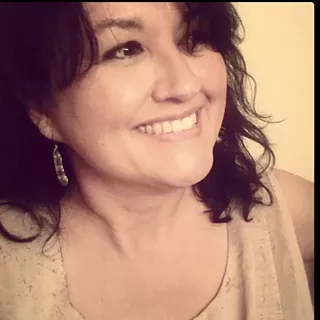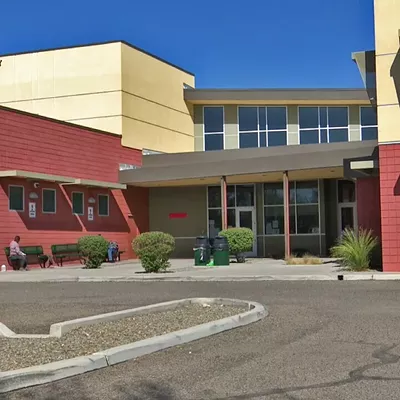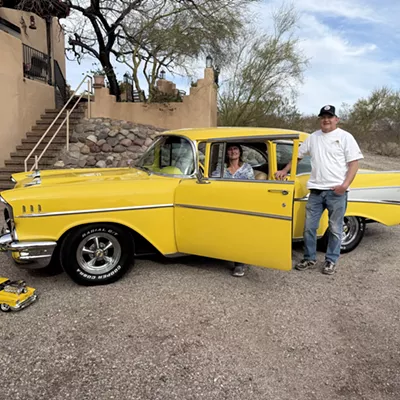Salomón R. Baldenegro is considered a legend in the local Chicano movement—and luckily, he's still around to set the record straight about what happened on Aug. 15, 1970, when a group of Chicano activists took over the city-run El Rio Golf Course.
Baldenegro says it was Sacramento Rodriguez, a grandmother, who led everyone on the historic day when activists marched on the golf-course greens to force the city to provide the Barrio Hollywood neighborhood with a park. Baldenegro said a group of residents and Chicano activists had been protesting in the golf-course parking lot, standing around a pickup truck where a group of college-age activists spoke about taking action.
"I was going to be the last speaker, and here I was waiting for my turn at the end, when an older woman yelled out—and that's how it started," recalls the now-retired former UA assistant dean for Hispanic student affairs and Chicano studies instructor.
"¡Ya basta con tanto hablar; vamos a ver nuestra parque!" Rodriguez yelled. In English, that's, "Enough talk; let's go see our park!" She turned around to head for the golf course, and everyone followed.
Baldenegro says the Arizona Daily Star—considered the pro-Democratic Party newspaper in those days—mischaracterized the westside-movement leaders as a group of radicals and anarchists, while the pro-Republican Party Tucson Citizen ran a front-page editorial in Spanish and English in support of the neighborhood.
However, the group never was radical, and Rodriguez is proof.
That march and a series of neighborhood protests that led to the creation of the El Rio Neighborhood Center and Northwest Park—later renamed Joaquín Murrieta Park—are being remembered at a 40th anniversary exhibit and celebration on Saturday, Dec. 18. From noon to 6 p.m. at the center at 1390 W. Speedway Blvd., there will be food and music, and certificates will be presented to those identified in the photos taken 40 years ago. Muralist David Tineo will also give a walking tour of the murals he created at the center.
"From my standpoint, it was a defining moment of the political evolution of the Chicano community," Baldenegro says about the events four decades ago. "If you look at the photos from that time, you see them—housewives, grandmothers, grandfathers, kids, whole families. That's important, because movements are usually run by a small group of activists, but not this one."
The photos in the exhibit include one that shows a group of housewives and grandmothers in a circle making burritos, as a group of riot-gear-wearing police protect the entrance of the golf course nearby. In another photo, a child is shown walking up to police to hand them burritos made by the women—who wanted to make sure the cops were fed.
Baldenegro says a series of events that led up to the 1970 golf-course takeover are important to remember. In 1967, a slate of candidates from the Democratic Party came to westside community leaders and asked for their support. At the time, the neighborhood still had unpaved roads and no sidewalks, yet was adjacent to the large, lush golf course.
"We had come to realize that they had taken advantage of us and taken us for granted. We said we wanted a park. 'OK, fine, we can do that,' they said. People went out to campaign, and the slate got elected. The next couple of years, we never saw the park, so at first, we did things through the system—wrote letters, petitions, met with them—but they kept rebuffing us and rebuffing us. At some point, they denied making the commitment, and that's when we started to take to the streets," Baldenegro says.
For five months, people protested in front of City Hall, in the Barrio Hollywood neighborhood and in front of the city-run golf course, which used to be an exclusive country club.
Then came the march on the greens.
"After that, things changed, and (politicians) stopped taking us for granted," Baldenegro says. "Another thing it did: It brought all kinds of people together. Then (the activism) spread to Barrio Anita, Barrio Pascua, to the eastside and southside. Everyone came together—black people, white folks, ministers, priests, nuns—marching out."
Sal Baldenegro Jr. grew up hearing his father's stories, which is why he and several friends decided to commemorate the park and center's 40th anniversary. Baldenegro and Patrick McKenna, along with Liz Saltero, Paul Natividad and Lane Santa Cruz, worked to identify 155 people in the photos, in order to recognize their work at the event.
"It is really important for us to know our history. These centers, these parks, they didn't come out of the ground one day; they were fought for very arduously," Baldenegro Jr. says. "In this anti-Latino climate, we have to know our history and recognize that it is incumbent upon us to fight for these things again. Russell Pearce and Tom Horne are going to try to take these things from us again, so we have to remember and at the same time give recognition. ... In the pictures, you'll see that it was such a cross-section."
McKenna, a seventh-generation Tucsonan who grew up in Barrio Hollywood, says he didn't even know his mother and aunts had participated in the marches until he started to help organize the event.
"Our own local narrative is becoming more and more important to our community. I know many of my friends who use the center didn't even know its history," McKenna says. "It's about celebrating the contributions of everybody. It's our history, our local Tucson history."








